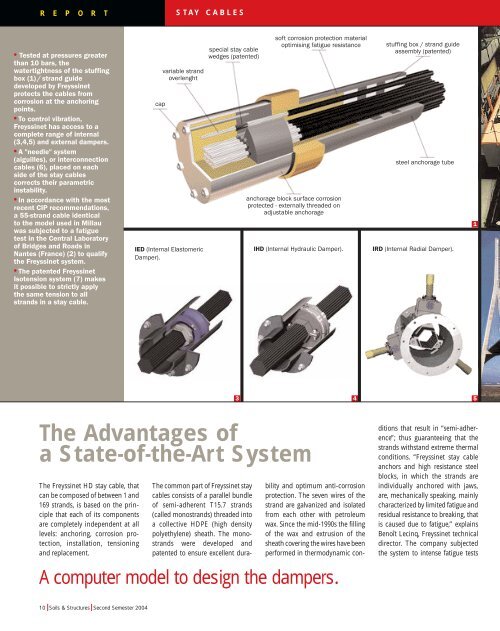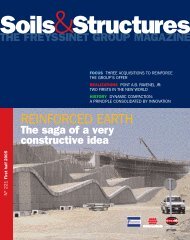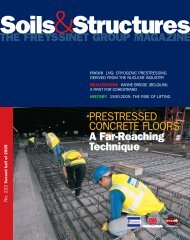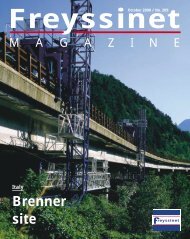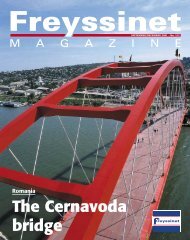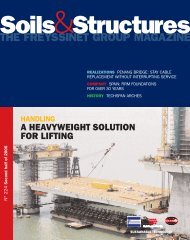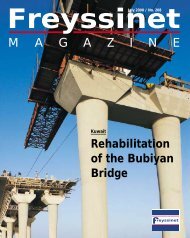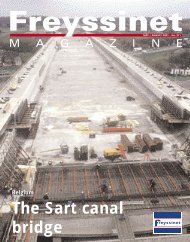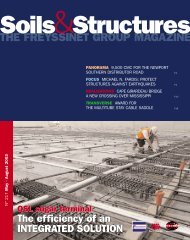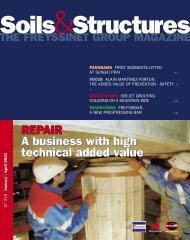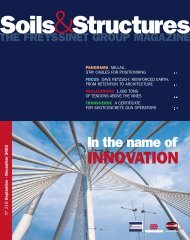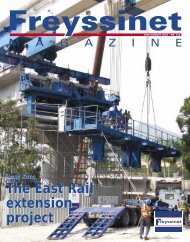STAY CABLE : The System in Top Form N°220 - Freyssinet
STAY CABLE : The System in Top Form N°220 - Freyssinet
STAY CABLE : The System in Top Form N°220 - Freyssinet
You also want an ePaper? Increase the reach of your titles
YUMPU automatically turns print PDFs into web optimized ePapers that Google loves.
R E P O R T <strong>STAY</strong> <strong>CABLE</strong>S<br />
• Tested at pressures greater<br />
than 10 bars, the<br />
watertightness of the stuff<strong>in</strong>g<br />
box (1) / strand guide<br />
developed by Freyss<strong>in</strong>et<br />
protects the cables from<br />
corrosion at the anchor<strong>in</strong>g<br />
po<strong>in</strong>ts.<br />
•To control vibration,<br />
Freyss<strong>in</strong>et has access to a<br />
complete range of <strong>in</strong>ternal<br />
(3,4,5) and external dampers.<br />
•A "needle" system<br />
(aiguilles), or <strong>in</strong>terconnection<br />
cables (6), placed on each<br />
side of the stay cables<br />
corrects their parametric<br />
<strong>in</strong>stability.<br />
•In accordance with the most<br />
recent CIP recommendations,<br />
a 55-strand cable identical<br />
to the model used <strong>in</strong> Millau<br />
was subjected to a fatigue<br />
test <strong>in</strong> the Central Laboratory<br />
of Bridges and Roads <strong>in</strong><br />
Nantes (France) (2) to qualify<br />
the Freyss<strong>in</strong>et system.<br />
•<strong>The</strong> patented Freyss<strong>in</strong>et<br />
Isotension system (7) makes<br />
it possible to strictly apply<br />
the same tension to all<br />
strands <strong>in</strong> a stay cable.<br />
cap<br />
variable strand<br />
overlenght<br />
IED (Internal Elastomeric<br />
Damper).<br />
special stay cable<br />
wedges (patented)<br />
soft corrosion protection material<br />
optimis<strong>in</strong>g fatigue resistance<br />
anchorage block surface corrosion<br />
protected - externally threaded on<br />
adjustable anchorage<br />
IHD (Internal Hydraulic Damper).<br />
stuff<strong>in</strong>g box / strand guide<br />
assembly (patented)<br />
steel anchorage tube<br />
IRD (Internal Radial Damper).<br />
1<br />
3<br />
4<br />
5<br />
<strong>The</strong> Advantages of<br />
a State-of-the-Art <strong>System</strong><br />
<strong>The</strong> Freyss<strong>in</strong>et HD stay cable, that<br />
can be composed of between 1 and<br />
169 strands, is based on the pr<strong>in</strong>ciple<br />
that each of its components<br />
are completely <strong>in</strong>dependent at all<br />
levels: anchor<strong>in</strong>g, corrosion protection,<br />
<strong>in</strong>stallation, tension<strong>in</strong>g<br />
and replacement.<br />
<strong>The</strong> common part of Freyss<strong>in</strong>et stay<br />
cables consists of a parallel bundle<br />
of semi-adherent T15.7 strands<br />
(called monostrands) threaded <strong>in</strong>to<br />
a collective HDPE (high density<br />
polyethylene) sheath. <strong>The</strong> monostrands<br />
were developed and<br />
patented to ensure excellent dura-<br />
A computer model to design the dampers.<br />
bility and optimum anti-corrosion<br />
protection. <strong>The</strong> seven wires of the<br />
strand are galvanized and isolated<br />
from each other with petroleum<br />
wax. S<strong>in</strong>ce the mid-1990s the fill<strong>in</strong>g<br />
of the wax and extrusion of the<br />
sheath cover<strong>in</strong>g the wires have been<br />
performed <strong>in</strong> thermodynamic conditions<br />
that result <strong>in</strong> “semi-adherence”;<br />
thus guarantee<strong>in</strong>g that the<br />
strands withstand extreme thermal<br />
conditions. “Freyss<strong>in</strong>et stay cable<br />
anchors and high resistance steel<br />
blocks, <strong>in</strong> which the strands are<br />
<strong>in</strong>dividually anchored with jaws,<br />
are, mechanically speak<strong>in</strong>g, ma<strong>in</strong>ly<br />
characterized by limited fatigue and<br />
residual resistance to break<strong>in</strong>g, that<br />
is caused due to fatigue,” expla<strong>in</strong>s<br />
Benoît Lec<strong>in</strong>q, Freyss<strong>in</strong>et technical<br />
director. <strong>The</strong> company subjected<br />
the system to <strong>in</strong>tense fatigue tests<br />
10 Soils & Structures Second Semester 2004


